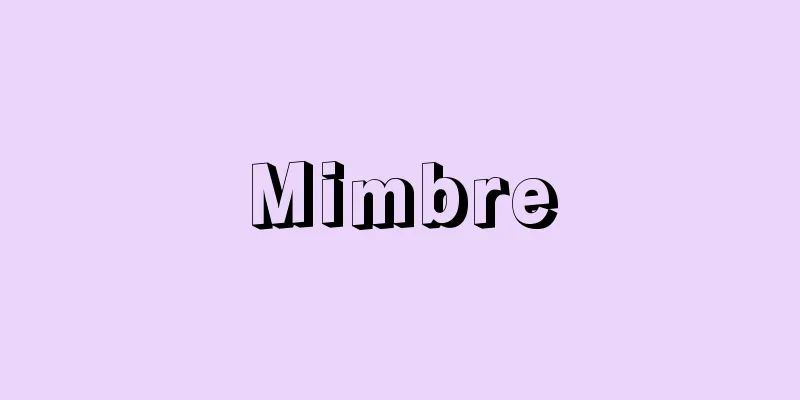Nucleic acid - Kakusan (English spelling)

|
The most important chemical substance for living organisms, it is a polymeric substance consisting of nucleic acid bases (purine and pyrimidine bases), pentose (five-carbon sugar, ribose or deoxyribose), and phosphate. It is essential for heredity, survival, and reproduction, and all living organisms on Earth, from the simplest viruses to humans, live based on nucleic acids. [Kenichi Kasai] Research HistoryIn 1869, Swiss JF Miescher (1844-1895) wanted to know what kind of substance was in the nucleus of a cell, so he chose pus that accumulates in a suppurating wound as a material that contains a lot of nuclei, extracted a substance that was not yet known at the time, and named it nuclein. The word "nucle" means nucleus. This is an acidic organic compound that contains phosphoric acid, and was later discovered in salmon sperm, animal thymus, yeast, and many other biological materials. In 1889, it was named nucleic acid because it was an acidic substance found in the nucleus. It was later discovered that nucleic acid exists not only in the nucleus but also in the cytoplasm. As chemical research progressed, it was discovered that there are two types of nucleic acid: deoxyribonucleic acid (DNA) and ribonucleic acid (RNA). It has been known that all living organisms have nucleic acid, but the importance of this substance was not clearly recognized until 1935 when American W.M. Stanley succeeded in obtaining a pure tobacco mosaic virus. This is a pathogen that infects tobacco leaves, but the purified virus was obtained as a crystal and did not look like a living organism at all. Moreover, chemical analysis revealed that it contained absolutely no biological substances such as sugars or lipids, and consisted only of proteins and nucleic acids. However, when the crystals were applied to tobacco leaves, the virus multiplied and the tobacco leaves developed mosaic disease. What this experiment showed was that even something that appears to be a simple non-living substance can produce its own offspring (self-reproduction), in other words, provide its offspring with the information necessary to create organisms just like itself, which is the most living thing that can happen. Next, in 1944, American bacteriologist O. T. Avery discovered that when DNA was purified from S-type pneumococci and given to R-type pneumococci, the offspring of the R-type pneumococci became S-type. This transformation phenomenon occurred by simply giving DNA, and no protein was required. In other words, the information (genetic information) that S-type parents gave to their offspring so that their offspring would also become S-type was contained in a substance called DNA. It was also discovered that mutations could be artificially induced by damaging DNA (changing its structure) using chemical or physical methods. DNA was the substance of genes predicted by G. J. Mendel in 1866. Furthermore, in 1953, J. D. Watson and F. H. C. Crick discovered that DNA molecules have a double helix structure in which two strands running in opposite directions are wrapped around each other. In 1956, A. Kornberg discovered an enzyme that uses DNA as a model to create the same DNA. In this way, the molecular-level mechanisms by which genetic information is distributed to offspring are gradually becoming clear. The role of RNA was unknown for a longer time than that of DNA. In some viruses, such as the tobacco mosaic virus, RNA functions as a gene, but these are merely exceptional cases in the entire kingdom of living organisms. What is the role of RNA in organisms other than bacteria that have DNA as a gene? By around 1950, it was known that RNA is not in the nucleus but in the cytoplasm, and that it is particularly abundant in cells where proteins are actively produced, and it was speculated that RNA is necessary for protein synthesis. In 1960, F. Jacob and J. L. Monod of France predicted the existence of messenger RNA, and its existence was eventually proven. It was then revealed that three types of RNA are essential for protein synthesis: messenger RNA, transfer RNA, and RNA contained in ribosomes. In 1961, M. W. Nirenberg succeeded in producing simple proteins in a test tube using artificial messenger RNA. This led to the deciphering of the genetic code, and it was discovered that RNA plays various roles in realizing the genetic information written in DNA in the form of proteins. Thus, it became widely accepted that genetic information is passed on in the following order among living organisms on Earth: DNA → RNA → protein. This law is the most fundamental principle for living organisms on Earth, and is known as the central dogma. However, it was soon discovered that this is not absolute. It was discovered that some RNA viruses that infect animals have reverse transcriptase, which synthesizes DNA using RNA as a model, and it was discovered that genetic information can also flow from RNA to DNA. Since the late 1970s, technology for studying the structure of nucleic acids has made remarkable advances, leading to the deciphering of the genes for many proteins. Genome projects, which aim to completely elucidate the DNA base sequence of a single species of organism, have also been actively carried out, and the complete DNA structures of a considerable number of microorganisms, as well as humans, fruit flies, nematodes and other multicellular organisms, have been elucidated. While this has been of great help to humanity in the prevention and treatment of diseases, it has also raised concerns about the impact it may have on individual privacy. Furthermore, technology has been developed to artificially create nucleic acids, to introduce them into bacteria such as E. coli, to grow them, and to have them create proteins based on the artificial genes. In this way, a way has been opened to artificially modify genes and create organisms with different characteristics from the original. This technology is called genetic manipulation or genetic engineering. [Kenichi Kasai] LocationThere are two types of nucleic acid, DNA and RNA, and all living organisms except viruses have both. In animal and plant cells, DNA is contained in chromosomes within the nucleus. The amount of DNA per cell is constant in every cell of a species, and does not increase or decrease. The only exception is reproductive cells, where the amount is exactly half due to meiosis. RNA is present in the cytoplasm of animals, plants, and bacteria, and its amount increases or decreases significantly depending on the state of the cell. Viruses have only one of either DNA or RNA. [Kenichi Kasai] structureThe chemical structures of DNA and RNA are very similar. Both are polynucleotides in which nucleotides (a substance consisting of one molecule of a nucleic acid base, a pentose, and a phosphate) are polymerized into a chain by phosphodiester bonds. Transfer RNA, a small nucleic acid, contains about 100 nucleotides, while DNA, which is a gene, contains more than several million nucleotides. The biggest difference between DNA and RNA is that the pentose (five-carbon sugar), one of the building blocks of nucleotides, is deoxyribose in DNA and ribose in RNA. In addition, both nucleic acids contain four main nucleic acid bases, two each of purine derivatives and pyrimidine derivatives, but while DNA contains adenine (abbreviated as A), guanine (G), thymine (T), and cytosine (C), RNA contains adenine, guanine, uracil (U), and cytosine, with uracil instead of thymine. Adenine and guanine are purine derivatives, while thymine, cytosine, and uracil are pyrimidine derivatives. Depending on the order in which these bases are arranged on the framework made of pentose and phosphate, an almost infinite variety of nucleic acids can be created. These bases also have an important property. The combinations of adenine and thymine, adenine and uracil, and guanine and cytosine tend to form hydrogen bonds between the bases. This is because the structural relationship is such that two hydrogen bonds are formed between adenine and thymine or uracil, and three hydrogen bonds are formed between guanine and cytosine. This type of relationship is called complementary, and the pair of bases formed in this way is called a complementary base pair, and is an essential property for nucleic acids to play various roles in life phenomena. DNA is a double helix in which two polydeoxyribonucleotides of opposite orientation are wound around each other, and all the bases in one strand form complementary base pairs with the bases in the other strand. In other words, once the arrangement of bases in one strand is determined, the arrangement of bases in the other strand is also determined. In RNA, there are few cases in which all the bases in a molecule are paired, but partial complementary base pairs are often formed, which allows the unique three-dimensional structure of transfer RNA to be formed. It is also important that complementary base pairs are formed temporarily when messenger RNA is synthesized using DNA as a template, or when transfer RNA comes into contact with messenger RNA for protein synthesis. [Kenichi Kasai] functionThe functions of DNA and RNA are briefly explained below. [Kenichi Kasai] Function of DNAWe now know that genes are DNA. Therefore, DNA must contain all the information necessary for a new organism to resemble its parent, or more precisely, to become an organism of exactly the same species as its parent. DNA is like a blueprint for creating an organism. However, it is not drawn on a flat piece of paper, but is written, metaphorically speaking, on a long piece of tape by lining up four types of codes, A, G, T, and C. A computer program can instruct any complex task using only two codes, 0 and 1, so four types of genetic codes is not a small number at all. Inheritance means that when a mother cell divides to produce two daughter cells, the mother cell's blueprint tape is doubled and distributed equally. How this happens at a molecular level can be clearly explained by the double helix structure of DNA. When a cell divides, the DNA of the mother cell unwinds and new, complementary strands are synthesized for each strand. This creates two identical sets of DNA from the mother cell, which are then distributed equally to the daughter cells. This process is called DNA replication. Since each daughter cell receives one half of the original double helix, it is also called semi-conservative replication. The Japanese scientist Okazaki Reiji (1930-1975) made a major contribution to elucidating this mechanism. So how can something as complex as a living organism be created with a design tape that uses only four codes, A, G, T, and C? This design tape mainly contains information for creating proteins. In other words, the way amino acids in proteins are linked is encoded using the way bases in DNA are linked. Since one amino acid is represented by a link of three bases, it is called a triliteral code. By arranging the triliteral code on the design tape, a huge variety of proteins (even a simple bacterium has at least several thousand types, and humans have 20,000 types) can be created. These proteins play a myriad of roles, including enzymes, hormones, antibodies, structural proteins, and more, and their orderly functioning allows living organisms to be born, grow, function, and reproduce. Since proteins contain 20 types of amino acids, only 20 types of genetic code are required. On the other hand, if a triliteral code is made up of four bases, 4 3 = 64 possible codes can be made. Three of these are used as punctuation marks, and the remaining 61 are assigned to the 20 amino acids. The triliteral code was deciphered from experiments using messenger RNA, so it is usually represented as the arrangement of bases on messenger RNA. When an error occurs in the genetic code on DNA, there is a possibility that the amino acids on a protein will be changed to the wrong ones. This is called a mutation, and occurs when DNA replication is not carried out correctly due to the effects of radiation or chemicals. If a protein with a partial error cannot fulfill its intended role, its offspring will be at a disadvantage in survival or may suffer from a genetic disease. Conversely, although this is very rare, it is also possible that a protein with a mistake will be superior to the original protein. It is through this accumulation that living organisms have evolved. [Kenichi Kasai] Function of RNAWhile the role of DNA is to store and transmit genetic information, the role of RNA is to materialize it. In other words, it works to promote protein synthesis. Three types of RNA are important here: messenger RNA (mRNA), ribosomal RNA (rRNA), and transfer RNA (tRNA). Messenger RNA is a copy of only the information necessary for the protein that needs to be synthesized in the long DNA. This is similar to DNA replication, and a single-stranded RNA that is complementary to one strand of the double helix (except thymine is replaced by uracil) is created. This process is called transcription, and takes place in the nucleus in higher organisms. Next, the messenger RNA leaves the nucleus and goes to a huge particle called a ribosome in the cytoplasm. The ribosome is a protein synthesis device that is a collection of dozens of proteins and three types of RNA (ribosomal RNA). Here, the work of linking amino acids according to the three-letter code of the messenger RNA is carried out. This is called translation. Amino acids themselves cannot read the code that represents themselves. Transfer RNA plays the role of an interpreter. There are as many types of transfer RNA as there are types of genetic codes, but each is specialized to correspond to a specific amino acid and a specific three-letter code. Although they are small, with a molecular weight of about 20,000 to 30,000, they have a site that binds to one specific type of amino acid and a site that binds to messenger RNA. The latter is a section in which three complementary bases are lined up so that it will only bind to the three-letter code for that amino acid. Therefore, transfer RNA binds a specific amino acid, and when the three-letter code for that amino acid appears on the messenger RNA, it can hand over that amino acid to the protein synthesis apparatus. In this way, amino acids are linked in a specified order to synthesize a protein. [Kenichi Kasai] Overview of genetic manipulationTo obtain the genetic DNA of a target protein, messenger RNA is extracted from cells that produce a large amount of that protein, and complementary DNA is made using reverse transcriptase. This is then incorporated into a loop of DNA (called a vector) that parasitizes bacteria. This operation is a kind of cut-and-paste technique, in which part of the vector is cut (using a special enzyme called a restriction enzyme), the target DNA is inserted into the cut, and then the vector is joined together with an enzyme called ligase to form a loop again. When this recombinant vector is allowed to parasitize bacteria, the incorporated DNA issues commands to produce messenger RNA, which then produces the target protein. Among the methods used in genetic engineering, the most revolutionary is the PCR method (polymerase chain reaction), invented by the American K. B. Mullis. It can amplify only a specific part of a DNA chain by more than a million times, so it is possible to elucidate the base sequence of the target part from a very small amount of DNA, and also to produce proteins based on the genetic code written in that part. The original double-stranded DNA is heated to separate into single strands. When a short DNA fragment (called a primer) that is complementary to the sequence at the end of the desired portion is added and the temperature is lowered, the primer binds and partially regenerates the double helix. When DNA polymerase is added, a complementary strand is synthesized starting from the primer. If this operation is performed on each of the two originally complementary strands, only the desired portion is amplified twice. The breakthrough in Mullis's invention was the use of a heat-stable DNA polymerase produced by heat-stable bacteria as an enzyme. This allows the doubled double helix to be heated again to separate each into single strands, and the same operation as described above can be repeated any number of times in a single test tube. One cycle of reaction proceeds simply by raising and lowering the temperature of the reaction solution, and the desired portion of the DNA is doubled, so 10 cycles will result in approximately 1,000 times, and 20 cycles will result in approximately 1,000,000 times. To explain the principle of this method with an analogy, it is like using negatives and positives in a photograph, making a positive from the negative, and a negative from the positive, and repeating the cycle to multiply by two, four, eight, and so on. This method is extremely useful, and is used in almost every aspect of life science today, including parentage testing, disease diagnosis, identification of criminals, identification of pathogens (pathogenic E. coli, bovine spongiform encephalopathy, etc.), and many other basic research. However, since it has become so easy to know an individual's genetic information, it has become necessary to handle it with great care so that it is not used as a tool for discrimination. With these methods, proteins that can only be obtained in very small amounts from animals can be produced in large quantities in bacteria such as E. coli. By using artificially synthesized DNA, it is possible to create proteins that do not exist on Earth. There are also attempts to revive extinct species, and while dinosaurs are not possible, mammoths may be possible in the near future. [Kenichi Kasai] [References] | | | | | | | | | | | | | | | |©Shogakukan "> Nucleic Acid Structure ©Shogakukan "> Chain structure of nucleic acid ©Shogakukan "> Complementary base pairs (hydrogen bonds between DNA bases) Base pairs and chain structures are visible. White is hydrogen, red is oxygen, yellow is phosphorus, blue is nitrogen, and black is carbon . DNA molecular structure model Source: Shogakukan Encyclopedia Nipponica About Encyclopedia Nipponica Information | Legend |
|
生物にとってもっとも重要な化学物質で、核酸塩基(プリンおよびピリミジン塩基)とペントース(五炭糖で、リボースまたはデオキシリボース)とリン酸からなる高分子物質。遺伝、生存、繁殖になくてはならない物質で、地球上の生物はもっとも簡単なウイルスから人間に至るまで、核酸を土台として生きている。 [笠井献一] 研究の歴史1869年にスイスのミーシャーJ. F. Miescher(1844―1895)は、細胞の核にどのような物質があるのかを知りたいと考え、核を多く含む材料として化膿(かのう)した傷口にたまる膿(うみ)を選び、当時まだ知られていなかった物質を取り出し、ヌクレインと名づけた。ヌクレが核を表す。これはリン酸を含む酸性の有機化合物で、その後にサケの精子、動物の胸腺(きょうせん)、酵母、そのほか多くの生物材料から発見され、核から発見された酸性物質ということから、1889年に核酸と名づけられた。のちになって核酸は核ばかりでなく細胞質中にも存在することが知られた。化学的研究が進むにつれて、デオキシリボ核酸(DNA)とリボ核酸(RNA)の二つのタイプがあることがわかった。あらゆる生物に核酸があることが知られてきたが、このものの重要性がはっきり認識されるようになったのは、1935年にアメリカのW・M・スタンリーが純粋のタバコモザイクウイルスを得るのに成功してからである。これはタバコの葉を侵す病原体であるが、純化されたウイルスは結晶として得られ、とても生物にはみえなかった。しかも化学分析によれば、糖とか脂質などの生体物質はまったく含まれておらず、タンパク質と核酸だけからなっていた。ところがこの結晶をタバコの葉に塗り付けるとウイルスが増殖し、タバコの葉はモザイク病になった。この実験からわかったことは、まるで生きていない単なる物質のようにみえるものでも、タンパク質と核酸さえもっていれば、自分の子孫をつくる(自己増殖)、いいかえると、自分と同じ生物をつくるために必要な情報を子孫に与えるというもっとも生物らしい行為ができるということである。 次に、1944年アメリカの細菌学者O・T・エーブリーは、S型とよばれる肺炎双球菌からDNAを精製し、それをR型とよばれる肺炎双球菌に与えると、R型の子孫がS型になってしまうことを発見した。この形質転換現象はDNAを与えるだけでおこり、タンパク質は必要でなかった。すなわち、S型の親がその子孫もまたS型になるようにと子孫に与えていた情報(遺伝情報)は、DNAという物質中にあったのである。またDNAを化学的あるいは物理的な方法で傷つける(構造を変える)ことによって、人工的に突然変異をおこしうることも知られた。DNAこそ、1866年にG・J・メンデルが予測していた遺伝子の実体だった。さらに1953年にJ・D・ワトソンとF・H・C・クリックが、DNA分子は逆方向に走った2本の鎖が互いに巻き付いた二重螺旋(らせん)構造をしていることを発見した。1956年にはA・コーンバーグが、DNAを手本として、それと同じDNAをつくる酵素を発見した。こうして、遺伝情報がどのようにして子孫に分配されていくかについての分子レベルでの機構も、しだいに明らかになってきた。 RNAの役割はDNA以上に長い間わからなかった。タバコモザイクウイルスなど一部のウイルスでは、RNAが遺伝子として働いているが、これらは全生物界からみれば、ほんの例外的存在にすぎない。遺伝子としてDNAをもつ細菌以上の生物でのRNAの役割はなんであろうか。1950年ころまでには、RNAは核の中ではなく細胞質にあり、とくにタンパク質が盛んにつくられている細胞に多いことが知られてきて、RNAはタンパク質合成に必要なものと推測された。1960年にフランスのF・ジャコブとJ・L・モノーがメッセンジャー(伝令)RNAの存在を予言し、やがてその実在が証明された。そしてタンパク質合成には、メッセンジャーRNAのほかに、転移RNA、リボゾームに含まれるRNAの3種類のRNAが不可欠であることが明らかになった。1961年にはM・W・ニーレンバーグが人工のメッセンジャーRNAを使って試験管内で簡単なタンパク質をつくらせることに成功した。これをきっかけとして遺伝暗号が解読され、またRNAは、DNAに記されている遺伝情報をタンパク質という形で実現するために、さまざまな働きをしていることがわかった。こうして地球上の生物においては、遺伝情報がDNA→RNA→タンパク質の順に伝えられてゆくという法則が広く認められるところとなった。なお、この法則は地球上の生物にとってもっとも基本的なことであり、セントラルドグマとよばれる。しかし、これが絶対的ではないこともやがて知られた。動物に感染するRNAウイルスの一部は、RNAを手本にしてDNAを合成する逆転写酵素をもつことが発見され、RNA→DNAという遺伝情報の流れもあることがわかった。 1970年代後半から、核酸の構造を研究する技術が著しく進歩し、たくさんのタンパク質の遺伝子が解読されるようになった。また、一つの生物種のDNAの塩基配列を完全に解明しようというゲノム・プロジェクトが盛んに行われるようになり、ヒト、ショウジョウバエ、線虫などの多細胞生物はもとより、かなりの種類の微生物について完全なDNA構造が解明された。このことは、人類にとって病気の予防や治療などに大きく役だつ反面、個人のプライバシーへの影響なども危惧(きぐ)される事態をもたらしている。 また人工的に核酸をつくる技術、それを大腸菌などの細菌の中へ入れて増殖させ、その人工遺伝子に基づいてタンパク質をつくらせる技術などが発展した。このようにして遺伝子を人工的につくりかえて、もととは違う特性をもつ生物をつくりだす途(みち)が開けた。このような技術を遺伝子操作あるいは遺伝子工学とよんでいる。 [笠井献一] 所在核酸にはDNAとRNAの二つの型があるが、ウイルス以外の全生物はその両方をもっている。DNAは動植物の細胞では核内の染色体に含まれている。細胞1個当りのDNAは、一つの種の生物については、どの細胞をとっても一定していて増減することがない。ただし、生殖細胞だけは減数分裂のため、ちょうど半量である。RNAは動植物および細菌を通じて細胞質に存在し、細胞の状態によって増減が著しい。ウイルスはDNAかRNAかのいずれか一方だけをもっている。 [笠井献一] 構造DNAとRNAの化学的構造はよく似ている。いずれもヌクレオチド(核酸塩基、ペントース、リン酸の各1分子が結合した物質)がリン酸ジエステル結合によって鎖状に重合したポリヌクレオチドである。小さな核酸である転移RNAで100個くらい、遺伝子であるDNAになると数百万個以上のヌクレオチドが重合している。DNAとRNAのもっとも大きな違いは、ヌクレオチドの構成単位の一つであるペントース(五炭糖)が、DNAではデオキシリボースであり、RNAではリボースであることである。また、いずれの核酸もおもな核酸塩基としてはプリン誘導体とピリミジン誘導体各2種類、計4種類を含むが、DNAではそれがアデニン(略号A)、グアニン(G)、チミン(T)、シトシン(C)であるのに対し、RNAではアデニン、グアニン、ウラシル(U)、シトシンであり、チミンのかわりにウラシルが含まれる点が異なる。なお、アデニンとグアニンはプリン誘導体、チミン、シトシン、ウラシルがピリミジン誘導体である。ペントースとリン酸でつくられた骨組みに、どのような順序でこれらの塩基が並ぶかによって、ほぼ無限の種類の核酸ができる。また、これらの塩基には重要な性質がある。アデニンとチミン、アデニンとウラシル、グアニンとシトシンという組合せは、塩基どうしの間で水素結合をつくりやすい。これは、アデニンとチミンあるいはウラシルとの間には2本、グアニンとシトシンとの間には3本の水素結合が、ちょうどうまくつくられるような構造関係にあるからである。このような関係を相補的、こうしてできる塩基の対(つい)を相補的塩基対とよんでおり、核酸が生命現象のなかでさまざまな役割を果たすために、なくてはならない性質である。 DNAは方向が逆の2本のポリデオキシリボヌクレオチドが互いに巻き付き合った二重螺旋であるが、片方の鎖にある塩基はすべてもう1本の鎖の塩基と相補的塩基対をつくっている。すなわち、片方の鎖の塩基の並び方が決まれば、相手の鎖の塩基の並び方も必然的に決まってしまうのである。RNAでは分子中の塩基のすべてが対になっている例は少ないが、部分的に相補的塩基対をつくることは多く、転移RNAの独特な立体構造などを形成させる。また、DNAを鋳型としてメッセンジャーRNAが合成されるとき、あるいは転移RNAがタンパク質合成のためメッセンジャーRNAと接触するときにも、一時的に相補的塩基対がつくられることが重要である。 [笠井献一] 機能DNAとRNAの働きについて、それぞれ簡単に述べる。 [笠井献一] DNAの働き遺伝子の実体はDNAであることがわかった。したがって、DNAには、新たに生み出される生物が親に似たものになるために必要な、もっと厳密にいえば、親とまったく同じ種の生物になるために必要な情報がすべて含まれていなければならない。DNAは一つの生物をつくるための設計図のようなものである。ただし、それは平らな紙に描かれたものではなく、たとえていえば、長いテープにA、G、T、Cという4種の符号を並べることによって記されているのである。コンピュータのプログラムは、0と1の二つの符号だけで、どんな複雑な仕事でも指示できるのであるから、遺伝子の符号が4種類というのはけっして少ない数ではない。遺伝が行われるということは、1個の母細胞が分裂して2個の娘(じょう)細胞ができるとき、母細胞のもっていた設計テープが2倍になって、平等に分配されることなのである。 これが分子のレベルでどのように行われるかは、DNAの二重螺旋構造から明快に説明される。細胞が分裂するとき、母細胞のDNAは螺旋がほどけて、それぞれの鎖に対して新しく相補的な鎖が合成される。このことによって母細胞のものと寸分違わぬDNAが2組できて、娘細胞に平等に分配される。このような工程をDNAの複製という。もとの二重螺旋の片方ずつが娘細胞に譲られるので、とくに半保存的複製ともいう。この機構の解明には、日本人の岡崎令治(おかざきれいじ)(1930―1975)が大きく貢献をしている。 さて、A、G、T、Cという4種の符号だけを使った設計テープで、どのようにして生物のような複雑なものを実現できるのであろうか。この設計テープには主としてタンパク質をつくるための情報が収められている。すなわち、タンパク質中のアミノ酸のつながり方が、DNAの塩基のつながり方を使って暗号化されているのである。三つの塩基のつながりで一つのアミノ酸が表されるので、三文字暗号とよばれる。三文字暗号を並べて書いた設計テープにより、膨大な種類のタンパク質(簡単な細菌ですら少なくとも数千種、人間ならば2万数千種類)がつくられる。それは、酵素、ホルモン、抗体、構造タンパク質、そのほか千差万別の役割を担っており、それらが秩序をもって働くことにより、生物は生まれ、成長し、活動し、子孫をつくるのである。 タンパク質に含まれるアミノ酸は20種類であるから、遺伝暗号も20種あればよい。一方、4種の塩基で三文字暗号をつくるなら、43=64通りの暗号をつくれる。このうちの三つは句読点として使われ、残りの61が20種のアミノ酸に割り当てられている。三文字暗号はメッセンジャーRNAを使う実験から解読されたので、普通はメッセンジャーRNA上の塩基の並び方として表される。 DNA上の遺伝暗号に間違いがおこると、タンパク質上のアミノ酸が間違ったものに変わってしまう可能性がある。これを突然変異というが、放射線や化学物質などの影響で、DNAの複製が正しく行われないときにおこる。そして一部に間違いのあるタンパク質が、本来の役割を果たせない場合には、その子孫は生存に不利が生じたり、遺伝病をもったりする。反対に、非常にまれではあるが、間違いのあるタンパク質が、もとのタンパク質よりも優れていることもありうる。このことの積み重ねで生物は進化してきたのである。 [笠井献一] RNAの働きDNAの役割が遺伝情報の保存と伝達であるのに対し、RNAの役割はその実体化にある。すなわち、タンパク質の合成を推進するために働いている。ここでは3種類のRNA、すなわちメッセンジャーRNA(mRNA)、リボゾームRNA(rRNA)、転移RNA(tRNA)がたいせつである。メッセンジャーRNAとは、長大なDNAのなかで、いままさに合成しなければならないタンパク質に必要な情報だけを写しとったものである。これはDNAの複製と似たやり方で、二重螺旋の片方の鎖に相補的な(ただし、チミンはウラシルに置き換えられる)1本鎖RNAがつくられる。この工程を転写といい、高等な生物では核の中で行われる。次にメッセンジャーRNAは核から出て、細胞質にあるリボゾームという巨大な粒子のところへ行く。リボゾームは数十種のタンパク質と3種のRNA(リボゾームRNA)が集合したもので、タンパク質合成装置である。ここでメッセンジャーRNAの三文字暗号に従って、アミノ酸をつなげてゆく作業が行われる。これを翻訳とよぶ。アミノ酸自身は、自分を表す暗号を読むことはできない。そこで通訳の役割を果たすのが転移RNAである。転移RNAは遺伝暗号の種類に相当するくらいの種類があるが、それぞれが、決まったアミノ酸と決まった三文字暗号に対応するように専門化されている。分子量は2万ないし3万くらいの小さいものであるが、定められた1種類のアミノ酸を結合する部位と、メッセンジャーRNAに結合する部位とをもっている。後者はそのアミノ酸に対する三文字暗号にだけ結合するように、三つの相補的塩基が並んだ部分である。したがって、転移RNAは、定められたアミノ酸を結合しておき、メッセンジャーRNA上にそのアミノ酸に対する三文字暗号が現れたとき、タンパク質合成装置にそのアミノ酸を手渡すことができる。こうして定められた順番にアミノ酸がつなげられて、タンパク質が合成されるのである。 [笠井献一] 遺伝子操作の概要目的とするタンパク質の遺伝子DNAを入手するため、そのタンパク質をたくさんつくっている細胞から、メッセンジャーRNAを取り出し、逆転写酵素を使って相補的DNAをつくらせる。これを細菌に寄生する輪になったDNA(ベクターという)に組み込む。この操作はいわば切り張り細工で、ベクターの一部を切断し(制限酵素という特殊な酵素を使う)、その切れ目に目的のDNAを挿入してから、リガーゼという酵素でつなぎ合わせ、ふたたび輪にする。この組換えベクターを細菌に寄生させると、組み込まれたDNAが指令を発し、メッセンジャーRNAがつくられ、さらに目的のタンパク質がつくられる。遺伝子工学で利用される手段のうちで、とくに画期的なものはPCR法(polymerase chain reaction法、ポリメラーゼ連鎖反応)で、アメリカのK・B・マリスが発明したものである。DNA鎖中の特定の部分だけを100万倍以上に増幅できるので、ごく微量のDNAをもとにして、目的とする部分の塩基配列を解明でき、またその部分に書かれている遺伝暗号に基づいてタンパク質を生産することもできる。もとになる二重螺旋DNAを加熱して、ばらばらの1本鎖状態にする。そこに目的とする部分の端の配列に対して相補的な短いDNA断片(プライマーとよぶ)を加えて温度を下げると、プライマーが結合して部分的に二重螺旋が再生する。そこにDNAポリメラーゼを加えると、プライマーを出発点として相補的に鎖を合成する。この操作をもとは相補的だった2本の鎖に対してそれぞれ行えば、目的部分だけが2倍に増幅される。マリスの発明の画期的だった点は、酵素として耐熱性細菌が生産する耐熱性DNAポリメラーゼを利用したことである。このことによって、倍化した二重螺旋をふたたび加熱して、それぞれ1本鎖とし、以下、前述したのと同じ操作を1本の試験管内で何回でも繰り返せるようになった。反応溶液の温度を上下させるだけで1サイクルの反応が進み、DNAの目的部分が倍化されるから、10回のサイクルで約1000倍、20回のサイクルで約100万倍になる。この方法の原理をたとえ話で示すと、写真のネガとポジを使って、ネガをもとにしてポジを、ポジをもとにしてネガをつくるというサイクルを繰り返して、2倍、4倍、8倍と増やしていくようなものである。この方法の有用性は限りなく大きく、今日のライフサイエンスのほとんどの場面で利用されている。親子鑑定、病気の診断、犯人の特定、病原体(病原性大腸菌、牛海綿状脳症など)の特定、その他多くの基礎研究などである。ただし、個人の遺伝情報をいとも簡単に知ることができるようになったため、それが差別の道具に使われたりしないよう、その取扱いについて十分に注意する必要がでてきた。 これらの方法で、動物からはごく微量しか得られないタンパク質でも、大腸菌などにたくさんつくらせることができる。人工的に合成したDNAを使えば、地球上に存在しないタンパク質を創造することも可能になる。絶滅した生物種をよみがえらせる試みもなされており、恐竜は無理としても、マンモスなら近い未来に実現するかもしれない。 [笠井献一] [参照項目] | | | | | | | | | | | | | | | |©Shogakukan"> 核酸の構造 ©Shogakukan"> 核酸の鎖状構造 ©Shogakukan"> 相補的塩基対(DNA塩基間の水素結合) 塩基対や鎖状構造が見える。白は水素、赤は酸素、黄はリン、青は窒素、黒は炭素©Shogakukan"> DNAの分子構造モデル 出典 小学館 日本大百科全書(ニッポニカ)日本大百科全書(ニッポニカ)について 情報 | 凡例 |
>>: Diffusion - Kakusan (English spelling) diffusion
Recommend
Allen, Louis Alexander
Born October 8, 1917 in Nova Scotia, Canada. Manag...
Sawatogarashi (Sawatogarashi) - Sawatogarashi (English name) Deinostema violaceum (Maxim.) Yamaz.
An annual plant of the Scrophulariaceae family tha...
Makiritare (English spelling)
An Indian tribe living mainly in Venezuela in Sout...
Zircaloy (English spelling)
A zirconium-tin alloy developed as a fuel cladding...
Baldovinetti, Alesso
Born: 1425. Florence Died 1499. Florence, Italy. F...
King Yamashiro no Oe - King Yamashiro
Year of death: 2.11 (643) Year of birth: Unknown A...
Mr. Hotta
His real surname was Ki. During the Nanboku-cho pe...
Medicago lupulina (English spelling) Medicago lupulina
…[Hoshikawa Kiyochika] [Ohashi Hiroyoshi]. … *Som...
Chingiz Aytmatov (English spelling)
A writer from the Kyrgyz Republic. He writes in K...
Hand-operated net - Tegriami
A fishing net consisting of a pouch net and wing n...
Croly, Herbert David
Born: January 23, 1869 in New York [Died] May 17, ...
Lord Kitoku
...It is a dance for one person, a dance of marti...
Kanhi - Kanhi
…Nine varieties were recorded in the Flower Bed C...
Temporary Palace Enthronement Ceremony - Kadensenzasai
… There are two types of relocation ceremonies at...
Side dance - gawaodori
...In the Edo period, the idea of amazed people...

![Kashimadai [town] - Kashimadai](/upload/images/67cb32e726a7b.webp)







